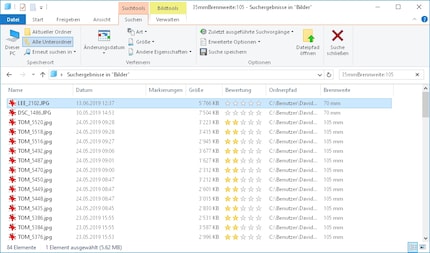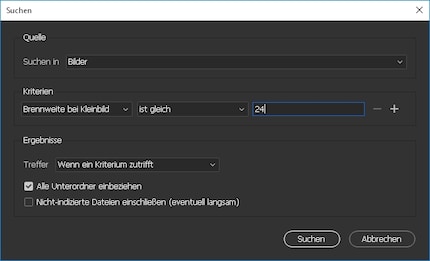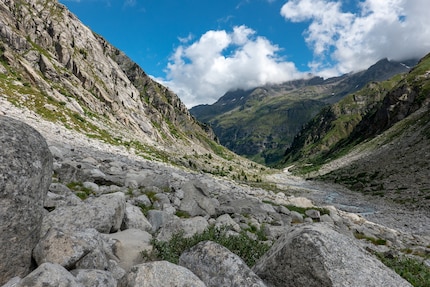
Guide
Beginner's photo tip: reserve a budget for lenses too
by David Lee

Would you like to buy a fixed focal length, but don't know which one makes the most sense? The photos you have already taken will give you a good indication. See which focal lengths you use the most when you can zoom.
Choosing the right lens is a science in itself. I have often recommended buying fixed focal lengths, i.e. lenses without a zoom. They are usually very fast without being large, heavy and expensive. This makes it possible to take photos with a depth effect and a blurred background.
How do you know what focal length(s) you need? It's easy with zooms: with two zoom lenses such as a 24-70mm and a 70-200mm, you have all the usual focal lengths covered. It's different with fixed focal lengths: Do you need both 35mm and 50mm? If not, which one is more important?
Rough rule of thumb: start with the standard focal length. That's 50 mm on a full-frame camera. For cameras with slightly smaller APS-C sensors, you can achieve the same image section with 35 mm, and with the even smaller Micro-Four-Thirds it is 25 mm. There is at least one inexpensive, fast and handy lens with a standard focal length for every camera system.
After your first experiences, you will quickly realise that sometimes the image section is too small and you need a wider angle, i.e. a shorter focal length. But sometimes you also need to be able to zoom in closer. Depending on how often you miss something, you'll know which direction your next purchase should take.
You can also take a different approach. Have you already taken photos with an inexpensive zoom lens or a compact camera? Then analyse your previous photos. You can easily count which focal lengths you have used and how often. This will tell you which image section is so important to you that a fixed focal length is worthwhile.
The actual focal length is stored in the metadata of your photos as well as the focal length that the respective image section would have on a full-frame camera. The latter is the correct value if you are interested in which angle of view you use the most.
In Windows, click on your image folder and enter the following in the search field:
35mm focal length:105
The search input will list all images with the converted focal length of 105 mm. It is important that you have selected the option "All subfolders". As already mentioned, the actual focal length is different if you are not using full format. This is the case for the first two images in the screenshot.

At the bottom left of the window you will see the total number of images found. Now you can compare by entering different values. Common focal lengths are 24, 35, 50, 70, 200 and 300 millimetres.
This input finds all images with 35mm focal lengths between 70 and 200 millimetres:
35mm focal length:>70<200
You can also search for 35mm focal lengths in the image management tool Adobe Bridge. Call up this dialogue with Ctrl-F.

In Lightroom, you can see the focal length distribution for each individual lens. I find this very useful in this context, because the total number alone can mislead you. The focal lengths you use depend on which lenses you have been using and for how long. Assuming that you have only photographed with one lens for years, it is hardly surprising that you have used this focal length range the most.

The disadvantage in Lightroom is that you only have the actual focal length and have to convert it to the 35mm focal length yourself.
I analysed the focal lengths of my photo collection to find out whether I could gain any insights into my preferences.
The zoom range of my Sony RX100 III compact camera is 24 to 70 mm in full-frame format. I took 2426 photos with it. Of these, 1096, or 45 per cent, had the minimum focal length of 24 mm. 437 had the maximum focal length of 70 mm. The rest are spread across 111 other focal lengths, none of which have more than 20 photos.
This is consistent with my experience. I find wide angles great for landscape shots and buildings. The maximum zoom is also interesting. If I'm too far away, I zoom all the way in. The focal lengths between 24 and 70 mm are less interesting.

With my Nikon lens, which ranges from 16-85 mm (35mm: 24-128 mm), the picture is similar. I saved 2050 photos from this lens. Of these, 743 or 36 per cent have the smallest focal length, 353 the largest. It is an APS-C lens - in full-frame format, the image section would also start at 24 mm.
The telephoto zoom 55-200 mm looks somewhat different: Of 1253 photos, 264 had the smallest focal length and 562 had the largest. Somehow clear: if you're going to use telephoto, then do it properly. That's why I replaced this lens after a while with a very similar one that goes up to 300 mm.
Somewhat surprisingly, I used the smallest focal length more often than the largest (205 and 178 photos, 624 in total).
I also replaced this telephoto lens as it was too slow for me. I have taken 791 photos with the 70-300 mm so far, of which only 46 were with the smallest focal length and 551 (70 per cent) with the largest.
I see two possible explanations for this:
Here is the whole thing in table form.
| Lens | Total photos | With min. focal length | With max. focal length | Rest |
|---|---|---|---|---|
| [Sony RX100 III (24-70)](/de/s1/product/sony-cyber-shot-dsc-rx100-iii-24-70-mm-2010mp-10fps-wlan-kamera-2581879) | 2426 | 1096 (45%) | 437 (18%) | 893 (37%) |
| [Nikon 16-85 (24-128)](/de/s1/product/nikon-af-s-vr-dx-16-85mm-f35-56g-ed-objektiv-280916) | 2050 | 743 (36%) | 353 (17%) | 954 (47%) |
| [Nikon 55-200 (83-300)](/de/s1/product/nikon-af-s-55-200mm-f4-56-vr-dx-objektiv-253622) | 1253 | 264 (21%) | 562 (45%) | 427 (34%) |
| [Nikon 55-300 (83-450)](/de/s1/product/nikon-af-s-dx-55-300mm-f45-56g-ed-vr-objektiv-268506) | 624 | 205 (33%) | 178 (29%) | 241 (39%) |
| [Nikon 70-300 (105-450)](/de/s1/product/nikon-af-s-70-300mm-f45-56g-vr-objektiv-280908) | 791 | 46 (6%) | 551 (70%) | 194 (25%) |
I own two fixed focal lengths: 35 and 50 mm. On my APS-C camera, these correspond to an image section of 50 and 75 mm respectively. In other words, the standard lens is the one with 35 mm, not the one with 50 mm.
| Lens | Pictures since the beginning of 2018 |
|---|---|
| [Nikon 35](/de/s1/product/nikon-af-s-dx-35mm-f18g-f22-18-35mm-objektiv-227978) | 491 |
| [Nikon 50](/de/s1/product/nikon-objektiv-50mm-f18d-af-nikkor-50mm-objektiv-203695) | 203 |
This surprises me, I would have bet that I use the 50 mm lens more often. It's my favourite lens, but that's obviously for sentimental rather than practical reasons.
I don't take photos the way I think I do. That alone is an interesting realisation. I take more wide-angle photos than I thought I would. And I take more photos with a standard angle of view than in the light telephoto, although I find the standard section rather boring compared to the light telephoto.
This realisation does not lead to a new purchase. I don't feel limited by my current lens collection anyway. But it's now clear that I'm keeping my hands off an expensive 85 mm portrait lens at the moment. I wouldn't use it enough.
What do you gain from analysing your own photo collection? Have you gained any insights?
My interest in IT and writing landed me in tech journalism early on (2000). I want to know how we can use technology without being used. Outside of the office, I’m a keen musician who makes up for lacking talent with excessive enthusiasm.
Practical solutions for everyday problems with technology, household hacks and much more.
Show all